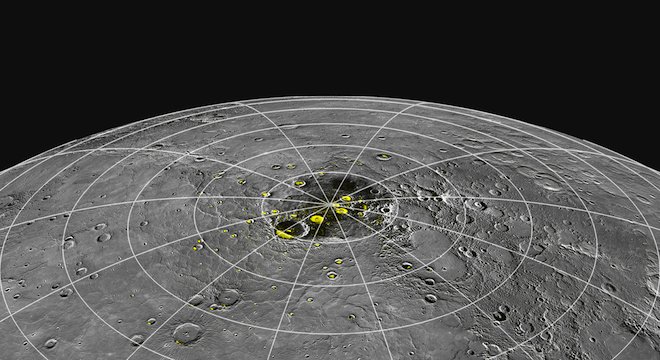Mercury, the planet in our Solar System closest to the Sun, appears to have plentiful deposits of water ice at its north and south poles, NASA announced on Thursday.
“We know of no other compound that measures the radar, the neutron spectrometry and the reflectance….than water ice,” said Sean Solomon, a geophysicist at Columbia University and the principal investigator of NASA’s MESSENGER spacecraft, which is the first to orbit Mercury, and which obtained the necessary data for the agency to announce the discovery in a NASA press conference streamed online Thursday afternoon.
The water ice appears to be collected in deep impact craters of comets and asteroids that have slammed into Mercury over millions of years, with most of the ice hidden from the Sun’s glare under deposits of organic material. Some ice remains exposed, but it too is located deep within the permanently shadowy part of craters at Mercury’s poles.
Solomon said that the MESSENGER spacecraft had performed three “stringent tests” — checking the areas thought to have ice with its neutron spectrometer, an instrument that detects the neutral subatomic particles emitted by surface elements, and its Mercury Laser Altimeter (MLA), a laser that beams light to the planet’s surface and records the variations in the time it takes to return, which can help map topography and the reflectiveness of surface materials such as ice.
Here’s a radar image of Mercury’s north pole, showing regions that are thought to contain water ice in yellow, published by NASA on Thursday:

And here’s another image showing Mercury’s north pole, with earlier Earth-based radar imagery showing shadowy areas in yellow, and new Mercury MESSENGER radar showing even more shadowy areas in red:

Further, the ice on Mercury is relatively thick — between 10 and 20 centimeters deep. Collectively, NASA scientists believe there is enough ice to blanket the entirety of Washington, D.C. in a layer of ice 2.5 miles deep, according to David Paige, a MERCURY participating scientist and geophysicist at the University of California, Los Angeles.
Paige also threw cold water on the idea that there was liquid water anywhere on Mercury.
“There are certainly temperatures that are conducive to liquid water but the problem with Mercury is that it doesn’t have an atmosphere,” Paige explained in the press conference. “While you could have meta-stable liquid water, you wouldn’t have a pond or a wet, soggy area, it would just turn to ice or evaporate.”
The theory that water ice could exist on Mercury of all planets, which has a high surface temperature of around 870 degrees fahrenheit and orbits the Sun at an average distance of 63 million miles, was first proposed in the early 1990s, based on radar imagery of Mercury taken from telescopes on Earth, namely the Arecibo radio telescope in Puerto Rico.
But it took the new measurements gathered by Mercury’s MESSENGER spacecraft, which was launched in 2004, and began orbiting the planet in 2011, to further strengthen those earlier results. The new findings are reported in three different papers published in the journal Science Express on Thursday.
NASA cautioned against the idea that water ice could be an indicator of life on the first planet from the Sun.
“Let me be clear, no one is saying there is life on Mercury,” Solomon said, but when on to note that the combination of water ice and organic matter may indicate the beginning of the processes necessary to create life.
“In terms of the book of life, there are some early chapters, and [water ice on] Mercury may help explain those,” Solomon said.
Further, Solomon noted that the finding of water ice on Mercury, along with earlier findings of water ice on our own Moon, indicate that all of the planets in our Solar System were likely peppered with water-bearing comets and asteroids from beyond the main asteroid belt. As he explained:
“Water is indeed a common component of our solar system, big component of the ice giant planets, covers many of our satellites, expected to be constituent of many objects in the outer solar system, beyond the asteroid belt. There’s a lot of water out there, as there is around other stars, but at substantial distance…there are mechanisms of perturbing the orbits of comets and asteroids…the history of water on our planet and the history of water ice on Mercury are very much history of interactions of comments and asteroids with the inner solar system. Alot of our water we now suspect, just as the material that’s likely to be water ice on Mercury, originated in a distant part of the solar system.”
NASA said that the only way to confirm further the presence of water on Mercury would be to land a spacecraft on it, which it has no concrete plans to do — yet.
Correction: This article originally misidentified the second image in the body, with red spots, as coming from Mercury’s south pole. In fact, it is another image of the north pole. This article also originally misspelled “comet” in two instances as “commet.” We have since updated the references in copy and regret the errors.






